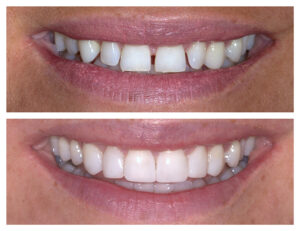A fracture, chipped teeth, stains on the front. We all love smiling, and doing this lets us show our full set of beautiful teeth. However, having chipped teeth with gaps or fractures can make us insecure about our smiles.
Luckily, modern dentistry and materials science has allowed us a cheap, quick, and non-invasive method of fixing such flaws for both aesthetic and functional purposes: composite bonding.
What is composite bonding?
Put simply, composite bonding is the use of a composite resin on the teeth to fill in gaps or restore the structure or ideal shape of teeth. It can also be used to cover up discolourations or stains that appear.
The good thing about composite bonding is that it’s a very versatile process that can be used for a wide variety of cases. On top of that, it doesn’t require the removal of your enamel (the protective outer tissue of teeth) so it is a reversible process.
Composite bonding, unlike crowns and veneers, also takes much less time and money because they do not require anaesthetics or drilling. The tooth structure is preserved so it is not a permanent process and can be removed, reshaped, or repaired accordingly.
Typically, patients get composite bonding to cover up any stains, markings, and discolouration caused by braces, especially on the front teeth. For those who would like to get teeth whitening treatment, composite bonding is often done after teeth whitening to further complement the aesthetic appearance of teeth. It is usually done after the whitening process so that the resin matches the whitened colour of the teeth perfectly.
The Process of Composite Bonding

Composite bonding can usually be done within one visit to the dentist as the process of bonding the resin is done quickly.
The process starts with the dentist choosing the composite resin that fits most nearly to the colour of the patient’s teeth. After this, they prepare the tooth for bonding by making its surface a bit rougher, helping the resin bond better to the tooth. The tooth is then coated with a kind of acid (which will not damage your tooth) that will further assist the bonding.
After this, the dentist will then begin applying the resin and mould it to the shape needed, then apply UV light to quickly set and harden it. Finally, they will begin polishing it out and making necessary adjustments if any.
Usually, multiple teeth can be done in one session. However, your dentist might set separate sessions to allow the gums to adjust to the new structure and shape before starting on the following teeth.
The composite, if taken care of properly, can last up to 5-6 years and would only need occasional polishing or repair to address any wear or chipping. However, it should be noted that these are not as durable as legitimate teeth so they might be chipped off or fractured when you eat hard or crunchy food. In any case, it is recommended to avoid eating such food or chewing using the teeth with composite bonding.
The Cost of Composite Bonding
Composite bonding is fairly cheap, especially when compared with alternatives such as crowns and veneers. However, unlike crowns and veneers, composite bonding is not covered by the NHS because it is primarily a cosmetic procedure. This means that you will have to approach private dental practitioners to avail of this service.
According to online sources, composite bonding in the UK ranges from £90 to £200, with the price starting at £150 for one source in London. Prices for composite bonding generally vary depending on the number of repairs needed.
For comparison, the same sources report crowns to be at around £450 to £800, priced differently if the material used is porcelain, gold, metal alloy, or metal alloy plated with porcelain. Veneers, on the other hand, cost £400 to £700. Both these processes require alteration of the tooth structure, particularly the removal of the enamel. This means that crowns and veneers are irreversible procedures and would require the deconstruction of some parts of your tooth.
Taking Care of Your Composite Bonding

In order to make sure your composite bonding procedure lasts for years, you need to take certain precautions. Composite bonding is less durable than natural teeth so they might chip more easily under pressure from biting. Because of this, it’s best to avoid biting on hard food using the teeth with composite bonding. This also includes any habits like biting on nails and pen lids.
Within the first 48 hours after the composite bonding is applied, try to avoid consuming tea and coffee or smoking as the material may still be setting and these substances can stain it. Staining also happens beyond the 48 hours, especially when you drink tea, coffee, or any sugary drinks frequently. Just make sure to brush your teeth often and drink water after consuming such drinks to avoid soaking your composite bonding in these substances.
Overall, composite bonding can be a great option for many dental cases. Whether you just need a fix on a chipped tooth or to cover up some stains and discolourations, you can be sure that composite bonding is versatile enough to meet your needs. If you’re confident you can take care of your teeth pretty well, this may be an amazing option so you don’t have to go through invasive procedures that permanently alter your teeth.
In the end, composite bonding can work for anybody and it’s up to you to ensure that you’ll get the most out of it.

